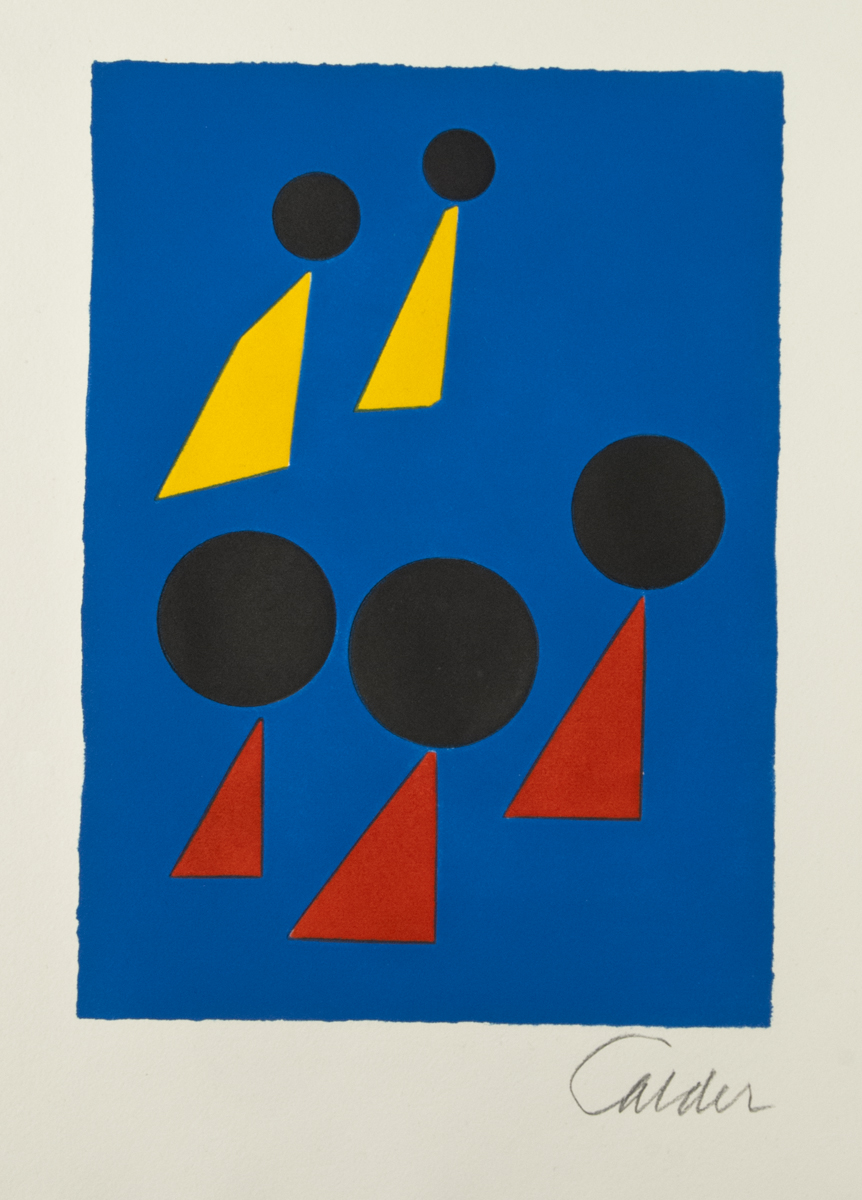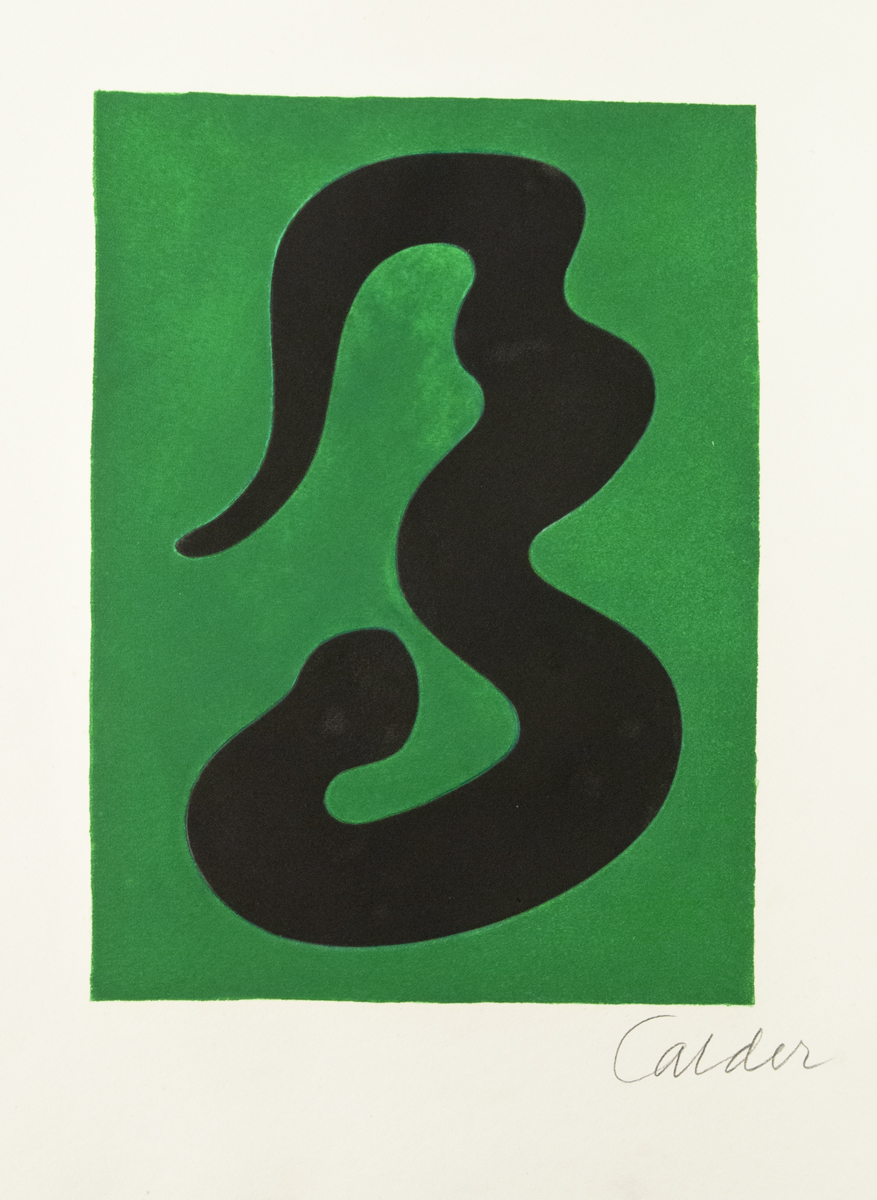
Alexander Calder, Balancier, gouache and ink on paper, 1969
Creating art with an engineer’s eye, Alexander Calder employed hieroglyphic models of the known world based on recurrent cultural symbols evoking the mysteries of science and art. According to his grandson Sandy Rower, Calder enigmatically said about his art: “…they are cosmic nuclear gases, deployed nuclei.” Marc Chagall co-mingled his own narratives from Russia and France with those from Ancient Greece and the Old Testament. He created a wonderland of dream imagery peopled with humans, spirits and animals—vivid and tangible to the heart. Joan Miró’s new figuration emerged in symbolic forms: eyes, moons, suns and planets. Miró said of these to his dealer Pierre Matisse, “I am working on small jewels like giant frescoes…I am like a bird flying between life and death.” Pablo Picasso appropriated Classicism to deconstruct 19th-century norms. While Picasso dazzled the viewer with his line and sense of composition, it was his personal involvement with the subjects and the emotions at play that brought his art to life.
~ Leslie Lund, Curator, Franklin Bowles Galleries, New York
Alexander Calder
Abstractions leading to monumental explorations of space
Alexander Calder evokes the sense of movement and dimensionality in a 2-D space in both the Fêtes series of pochoir prints created in 1971 with the French poet, Jacques Prevert, and in the gouache study for the Universe, a monumental multi-piece mobile and stabile created for the Sears Tower in Chicago. Within these abstractions, forms coil and float rhythmically giving the viewer the sense of an infinite space/time continuum. Creating art with an engineer’s eye, Calder employed hieroglyphic models of the known world based on recurrent cultural symbols evoking the mysteries of science and art. According to his grandson, Sandy Rower, Calder enigmatically said about his art: “…they are cosmic nuclear gases, deployed nuclei.”
Marc Chagall
Psychological surrealist worlds accessed via dream imagery
Floating couples, bouquets of flowers that speak of eternal love, and whimsical animals appear with random regularity throughout Marc Chagall’s art. He inhabited a separate space, a parallel reality composed of his childhood memories from Russia and joyous experiences in Paris during the many years he lived there. Adopted by the French, Chagall continually told stories that took him back to the ancient world of the Greeks or to the Old Testament. These historical narratives co-mingled with his own narrative evolving into a wonderland peopled with humans, spirits and animals—all vivid and tangible to the heart.
Joan Miró
Inventive ways of describing new figuration with references to music and mysticism
Passionate and political, Joan Miró was immersed in the languages of poetry and music—specifically Bach and Mozart, as he worked on his Constellations in the 1940s. His images of eyes, moons, suns and planets enabled Miró to escape the horror, exile and disenfranchisement generated by the wars around him. His art was created in a process of spiritual introspectiveness; his grandson described it as if his spirit ‘had escaped the cage of flesh and bones.’ The recurrent images from Constellations would inhabit his art into the 1970s and 80s. Miró said of these pieces to his dealer Pierre Matisse, “I am working on small jewels like giant frescoes…I am like a bird flying between life and death.”
Pablo Picasso
Classicism appropriated to deconstruct 19th century norms
After Cubism, Pablo Picasso returned to the neo-classical style of his early drawings. The 1927 Vollard etching, Painter in front of his easel with a model with long hair, echoes his ongoing exploration of sensuality and voyeurism. The artist and model is a theme that would occupy every facet of Picasso’s being and personal life and show up in his art throughout his career.
In another Vollard-period image, Picasso shows the myth of Cupid and Psyche in Boy with sleeping woman illuminated by a candle. Here the roles of Cupid and Psyche are reversed and it is the man (Picasso, the artist), studying his muse (Marie-Therese Walter) as she sleeps. In the first state of this etching that we have in our exhibition, there is a light touch to the figures. In the final state of this print, the artist’s obsession is evidenced in the multiple re-workings of the plate. Picasso dazzles the viewer with his line and sense of composition, but it is the personal involvement and the emotions at play that bring the image to life.





































